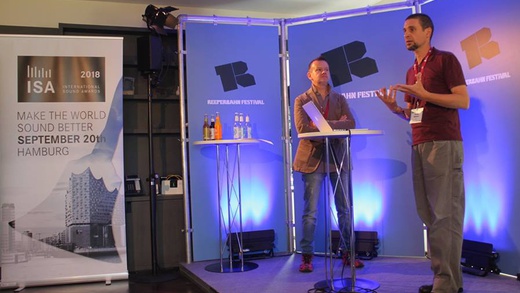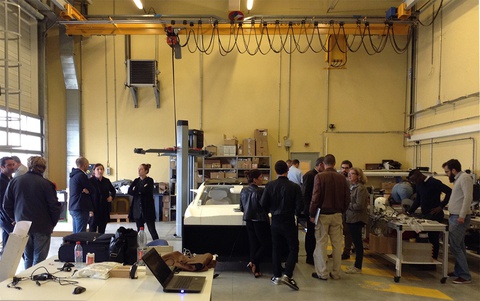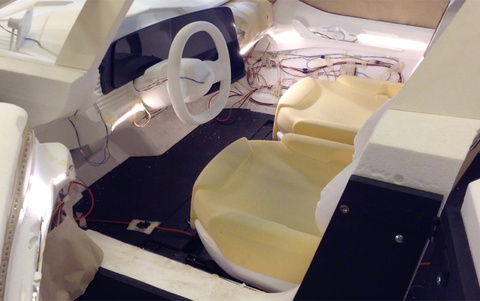Rencontre avec Nicolas Misdariis et Andrea Cera
Le chercheur de l’équipe Perception et design sonores et le compositeur Andrea Cera, associé au projet, viennent d’être distingués par l’Audio Branding Academy pour leur conception et réalisation du design sonore de la Renault Symbioz.
 Nouvelle démo-car électrique et autonome, la Renault Symbioz représente la vision de l’automobile de 2030 pour Renault ; elle a été dévoilée lors de l’édition 2017 du Salon de l’Automobile à Francfort, où les journalistes ont même eu l’opportunité de l’essayer. La signature sonore du véhicule est le fruit d’une collaboration industrielle entre les laboratoires de Design et Innovation du constructeur automobile et l’équipe Perception et design sonores de l’Ircam, représentée par l’ingénieur-chercheur Nicolas Misdariis et le compositeur Andrea Cera. Le travail de design sonore de la Renault Symbioz a répondu à deux challenges : la conception d’un son de signalétique avertissant les piétons de la présence du véhicule, et la conception d’une gamme de sons destinés à l’habitacle de la voiture.
Nouvelle démo-car électrique et autonome, la Renault Symbioz représente la vision de l’automobile de 2030 pour Renault ; elle a été dévoilée lors de l’édition 2017 du Salon de l’Automobile à Francfort, où les journalistes ont même eu l’opportunité de l’essayer. La signature sonore du véhicule est le fruit d’une collaboration industrielle entre les laboratoires de Design et Innovation du constructeur automobile et l’équipe Perception et design sonores de l’Ircam, représentée par l’ingénieur-chercheur Nicolas Misdariis et le compositeur Andrea Cera. Le travail de design sonore de la Renault Symbioz a répondu à deux challenges : la conception d’un son de signalétique avertissant les piétons de la présence du véhicule, et la conception d’une gamme de sons destinés à l’habitacle de la voiture.
Nicolas Misdariis et Andrea Cera nous en disent plus sur ces nouveaux défis liés à l’émergence de modes de conduite autonome, au moment même où leurs travaux pour la démo-car viennent d’être distingués par les professionnels internationaux comme « Better Sound 2018 » de l’Audio Branding Academy.
Nicolas Misdariis, Andrea Cera, ce n’est pas votre première collaboration de design sonore avec Renault ; quelle est l’originalité du projet de la Renault Symbioz ?
La Renault Symbioz est la promesse d’une fusion entre véhicule et espace de vie. Le projet porte une attention toute particulière au confort et à la quiétude du passager, ainsi qu’à l’expérimentation des nouvelles technologies pour le contrôle du comportement de la voiture et l’ambiance à l’intérieur du cockpit. Il comporte deux challenges : la conception d’un son externe qui avertit les piétons de la présence du véhicule (la signature sonore), et la conception d’une gamme de sons destinés à l’habitacle de la voiture (les sons du cockpit).

La Renault Symbioz © Renault
Pouvez-vous nous en dire plus sur cette nouvelle signature sonore ?
Elle est activée lorsque la vitesse de la voiture se situe entre 0 et 30 km/h –, une plage de vitesse durant laquelle la voiture électrique est potentiellement silencieuse. Ses caractéristiques sont issues de deux projets précédents élaborés par la même équipe : la signature sonore de la Renault Trezor (un concept car) et de la Renault Zoé (un modèle commercialisé).
La signature sonore de la Symbioz est un hybride entre composants électriques et turbine, avec une touche de moteur à combustion, puissante sans être agressive. Quand le moteur est au ralenti, il émet de courtes séquences sonores à la fois douces et aigues créant ainsi un langage abstrait (résultant de l’émergence d’éléments appelés « agents audio ») et avertissant les piétons que le moteur est allumé. Le prototype du son est créé dans l’environnement de prototypage et de création sonore Max puis convertit dans un langage propriétaire.
Et comment avez-vous conçu les sons de l’habitacle ?
La Symbioz est également un vrai laboratoire d’étude pour les sons de cockpit du futur. Nous avons développé un ensemble d’interfaces homme-machine sonores (IHM) innovantes dans deux directions distinctes.
Tout d’abord l’exhaustivité : nous avons traité la totalité des interactions conducteur/passager/cockpit, liées aux modes de fonctionnement de la Symbioz. A ce titre, la possibilité d’un mode de conduite autonome implique de nouveaux challenges au niveau du design : comment communiquer les différents niveaux d’autonomie de la voiture ? Comment rassurer les passagers lorsque la voiture est en mode de conduite autonome ? Pour cela, nous avons travaillé avec une forme de partition, pour assurer la cohérence des sons avant de les réaliser. Dans un deuxième temps, nous avons créé un prototype dans l’environnement Max afin de traduire cette partition dans une collection d’esquisses sonores. Enfin, nous avons transformé ces esquisses en sons qualitatifs, en utilisant des matières sonores captées sur les matériaux présents dans l’habitacle (travail de Janick Deneux, étudiant en design sonore a l’ESAD TALM Le Mans).


Dans les espaces de Innovation Lab, tests de synchronisation son/lumière
La seconde direction est la spatialisation : nous avons développé un concept original d’IHM sonores spatialisées. Chaque son émis dans le cockpit de la Symbioz (clignotants, alarmes, sons informatifs...) est positionné dans un espace acoustique virtuel. La voiture dispose de trois modes de conduite (Classique, Dynamique, Autonome). Dans chaque mode, les sons tournent légèrement autour de positions virtuelles, avec divers degrés de modulation et de réverbération. Par exemple, dans le mode Dynamique, les clignotants sont placés de façon très stable dans la direction que la voiture va emprunter. Dans le mode Autonome, la localisation des clignotants est beaucoup plus souple puisque qu’aucun passager ne se concentre sur la conduite. En bougeant dans l’espace, les IHM sonores deviennent moins gênantes et plus naturelles – les changements de position se traduisent par de subtiles altérations de timbre dûes au déphasage et à la réverbération sur les parois de l’habitacle.